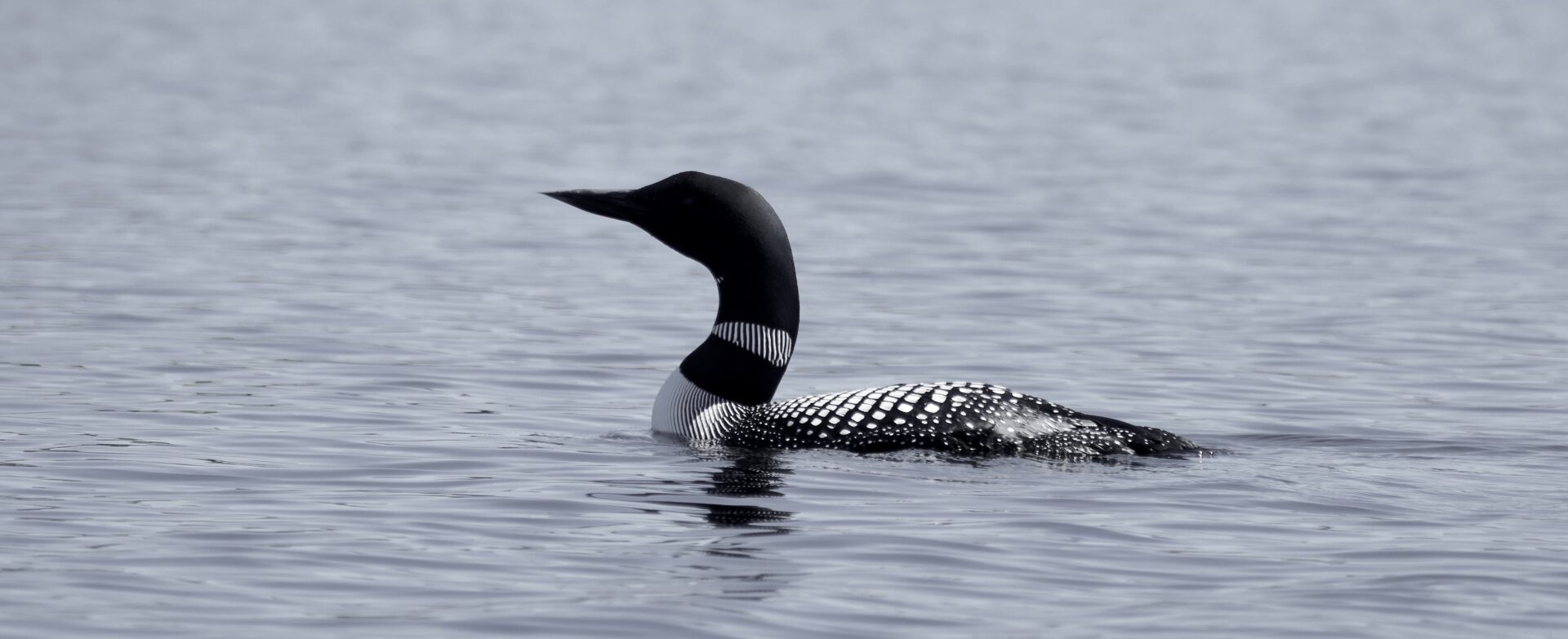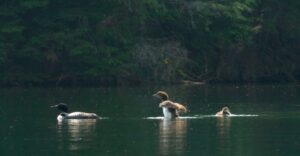The Nature of Loons: An Afternoon on the Pond

By Emily Sloan, Office Manager
My paddle sweeps and swishes, a light breeze floats along the water surface, and I am happy to be out on the pond on this July day, seeking a pair of nesting loons who hatched two chicks earlier this month.
For more than a decade, I have volunteered to monitor specific lakes and ponds for loon nesting and activity. The Vermont Loon Conservation Project is a state-wide effort to restore and maintain the population of Common Loons in Vermont. This project is run jointly by the Vermont Center for Ecostudies (VCE) and the Vermont Fish & Wildlife Department. It began more than four decades ago with seven pairs of loons, and has now reached more than 100 breeding pairs. Volunteers from all over the state head out from May through September to monitor nesting locations, chicks hatched, predation, injuries, and rescues. Midway through the summer VCE hosts a “Loon Watch Day” that invites people to monitor a pond or lake of their choice for a few hours to collect loon numbers on more than 160 water bodies. Then, as fall approaches, there is a final count of surviving loon chicks soon to take flight.
Today I am seeking a loon parent with chicks to see if they are still alive and well. Once the young are hatched, families rarely return to the nest, and the chicks often spend time on the backs of their parents for protection and warmth. Males and females look identical to human eyes, and both tend to the nest and chicks equally.
 As I meander up the pond my eye catches a glimpse of a splash. Yes! A parent and two offspring are together a distance ahead. I continue to paddle along the shore, watching and keeping a safe distance so as not to disturb the loons’ activities. At one point I stop, completely mesmerized: the parent is feeding the chicks! Over and over, she (or he) dives, and moments later resurfaces with a minnow, crayfish, snail, or frog, splashing her catch in the water to make it seem alive — but it is not. She feeds one chick, dives again, and feeds the other. This pattern continues for well over 30 minutes as I watch the carefully calculated delivery of the goods to one chick, then the other. Surprisingly I observe no competition between the chicks; they appear content with how the parent shares their finds.
As I meander up the pond my eye catches a glimpse of a splash. Yes! A parent and two offspring are together a distance ahead. I continue to paddle along the shore, watching and keeping a safe distance so as not to disturb the loons’ activities. At one point I stop, completely mesmerized: the parent is feeding the chicks! Over and over, she (or he) dives, and moments later resurfaces with a minnow, crayfish, snail, or frog, splashing her catch in the water to make it seem alive — but it is not. She feeds one chick, dives again, and feeds the other. This pattern continues for well over 30 minutes as I watch the carefully calculated delivery of the goods to one chick, then the other. Surprisingly I observe no competition between the chicks; they appear content with how the parent shares their finds.
However, the anxiety is palpable within my body — the parent dives for several minutes at a time while the fluffy little chick bodies bob upon the surface, completely exposed to any circling raptor, snapping turtle, or large fish. For the first eight weeks of their lives, chicks are dependent upon parents to bring them food. I remain still and present, hopeful all will be fine. I keep watch.
I would compare this moment — this hour of full attention — to a cup overflowing with surprise and excitement, followed by contentment at witnessing the wonder of care in the wild. It is instinctual, no doubt, and I wonder how we humans can learn from this type of connection that comes with the responsibility of taking care of one another — our families and communities.
As I turn my paddle towards the shore, I am hopeful this loon family will remain safe, the chicks will mature healthy and strong, and that once they leave for wintering waters they will return again another year, keeping this cycle of life and rebirth moving forward.
To get involved with the Vermont Loon Conservation Project, please email: [email protected].

